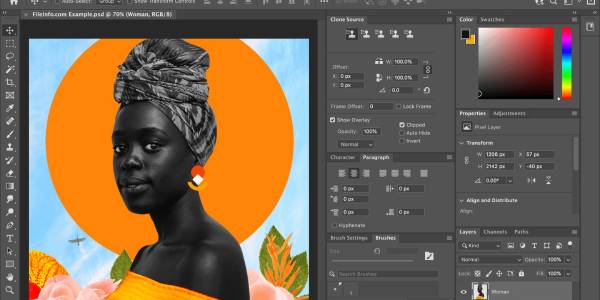
Looking to make your photos shine without breaking the bank? Whether you’re a casual photographer or a social media pro, finding the right online photo editor can take your images to the next level. In this guide, I’ll walk you through the best online photo editing software for 2025, comparing both free and premium tools to help you find what works best for your needs.
Why Opt for Online Photo Editing?
Online photo editors are becoming more popular, and it’s easy to see why. Here are some of the main benefits:
-
No Downloads: Start editing right away in your browser—no installation needed.
-
Access Anywhere: Edit photos from any device, whether you’re on a laptop, tablet, or phone.
-
Regular Updates: These tools get updated automatically, so you always have the latest features.
-
Affordable Options: Many online editors have free plans, with premium options that won’t empty your wallet.
Let’s dive into the best options for 2025.
Top Free Online Photo Editing software for 2025
1. Google Photos: Easy, AI-Powered Edits
Once just a storage tool, Google Photos has become a surprisingly powerful editor. With its simple interface and smart AI tools, it’s a perfect choice for those looking for quick fixes and automatic enhancements.

Why You’ll Love It:
-
Smart AI Tools: Automatically brighten, adjust, and enhance your photos with a click.
-
15GB Free Storage: Plenty of room for your images without paying for extra space.
-
Cross-Platform: Access your photos anywhere—on mobile or desktop.
Downsides:
-
Basic tools, no layers, and limited control over advanced edits.
2. Photopea: Free Photoshop in Your Browser
If you’re familiar with Adobe Photoshop but don’t want to pay for it, Photopea is your free alternative. This online editor brings the power of Photoshop right to your browser, with many of the same features.
Key Features:
-
Layer-Based Editing: Supports PSD files and offers advanced editing features like layers and masks.
-
Raw File Support: Perfect for photographers working with RAW images.
-
Free & Fully Functional: Ad-supported, but free to use.
Drawbacks:
-
Ads in the free version can be a little annoying.
-
Can run slower with bigger projects.
Best Premium Online Photo Editors
3. Adobe Lightroom (Web Version): Pro-Level Editing
For serious photographers, Adobe Lightroom offers a web version that brings its professional-grade tools to your browser. While it comes at a price, its cloud-based features and editing power make it worth it for those serious about photography.

Why It’s Great:
-
AI Presets: Automatically enhance photos with AI-powered filters and adjustments.
-
Cloud Sync: Edit across devices and store your photos in the cloud.
-
RAW Support: Handle high-quality, professional photos with ease.
The Catch:
-
Cost: Starts at $9.99/month.
-
Learning Curve: It can take some time to master all the advanced tools.
4. Colorcinch: Affordable and Packed with Features
If you want professional editing tools without the steep price, Colorcinch is a fantastic option. At just $4.99 per month, it’s great for beginners and intermediate users who need solid editing capabilities without the complexity of top-tier tools.

Why Colorcinch Stands Out:
-
AI-Powered Tools: Instantly remove backgrounds or apply artistic filters with a single click.
-
User-Friendly: A simple, intuitive interface that’s easy to grasp.
-
Social Media Integration: Easily share your photos on platforms like Instagram and Facebook.
Key Features:
-
Selective Editing: Adjust specific colors and tones.
-
Cloud Integration: Connect to Google Drive for seamless photo editing.
Other Notable Photo Editors for 2025
5. GIMP Online: Power without the Price
GIMP is a well-known, open-source software that’s now available online. While it’s more complex than some other editors, it’s one of the most powerful free tools you can use—especially if you’re familiar with Photoshop.

Why It’s Worth Trying:
-
Advanced Tools: Layer editing, advanced selection tools, and customizable brushes.
-
Free Forever: No subscription, no cost, just great editing features.
-
Powerful Interface: Familiar to users who’ve worked with Photoshop.
6. Fotor: AI-Powered Magic
Fotor stands out for its AI-enhanced editing tools, making it perfect for quick, beautiful edits. It’s especially great for portrait editing, where you can enhance facial features while keeping things natural.

What Makes Fotor Special:
-
Batch Processing: Edit multiple photos at once—a great time-saver.
-
AI Art Styles: Turn your photos into paintings or sketches with a click.
-
Easy-to-Use Interface: Ideal for those who want powerful tools but don’t want to deal with a complex program.
7. Picsart: Perfect for Social Media Creators
If your main focus is creating eye-catching content for social media, Picsart is one of the best platforms out there. It’s packed with creative tools designed specifically for making fun, shareable posts.

Why Content Creators Love It:
-
Vast Library of Templates: Find everything from photo collages to Instagram Stories templates.
-
AI Tools: Automatic background removal and special effects that are easy to apply.
-
Active Community: Share your designs and get inspiration from others.
Comparison Table
Here’s a quick comparison to help you decide which photo editing tool best suits your needs:
|
Feature |
Google Photos |
Photopea |
Adobe Lightroom (Web) |
Colorcinch |
GIMP Online |
Fotor |
Picsart |
|
Free Version |
Yes |
Yes |
No |
Yes |
Yes |
Yes |
Yes |
|
Price (Premium) |
N/A |
N/A |
$9.99/month |
$4.99/month |
Free |
$8.99/month |
$11.99/month |
|
AI Features |
Yes |
No |
Yes |
Yes |
Yes |
Yes |
Yes |
|
Layer Support |
No |
Yes |
Yes |
Yes |
Yes |
Yes |
Yes |
|
RAW File Support |
No |
Yes |
Yes |
No |
Yes |
Yes |
Yes |
|
Batch Editing |
No |
No |
Yes |
Yes |
No |
Yes |
Yes |
|
Cloud Storage |
Yes |
No |
Yes |
Yes |
No |
Yes |
Yes |
|
Device Compatibility |
Multi-device |
Multi-device |
Multi-device |
Multi-device |
Multi-device |
Multi-device |
Multi-device |
Use Cases: Find the Right Editor for Your Needs
-
For Quick Edits & Enhancements: If you need something simple for quick edits, Google Photos and Fotor are great choices.
-
For Professional Work: Photopea and Adobe Lightroom are ideal for photographers working with RAW images or those who need advanced features like layers and masking.
-
For Social Media Content: Picsart and Colorcinch excel in creating eye-catching content for social media, with tons of templates and creative effects.
-
For Free, Powerful Editing: GIMP Online is a top free choice for those looking for complex tools without the cost.
Step-by-Step Tutorials: How to Use Key Features
Using AI Filters in Fotor:
-
Upload your photo to Fotor.
-
Select the AI Effects tab.
-
Choose a style like HDR or Artistic.
-
Apply the effect and fine-tune the intensity.
-
Save and download your enhanced image.
Editing Layers in Photopea:
-
Open Photopea and upload your image.
-
Use the Layer menu to create new layers.
-
Apply effects like masks, blurs, or adjustments to each layer.
-
Once satisfied, export your project as a PSD or JPEG.
Common Mistakes to Avoid
-
Overusing Filters: It’s easy to get carried away with AI filters, but subtlety often produces the best results.
-
Not Saving in the Right Format: Always save in the right format (e.g., JPEG for web, TIFF for print).
-
Ignoring Image Resolution: Low-resolution images can look pixelated, especially when printed.
Future Trends in Online Photo Editing software
In 2025 and beyond, expect to see more AI-driven features, like automatic scene recognition and enhanced image stabilization. Cloud-based tools will also become more collaborative, allowing teams to work on photos simultaneously, even in real time. Augmented Reality (AR) could also be integrated for virtual try-ons or digital makeup edits.

Final Verdict: Which Photo Editor is Right for You?
Here’s a quick recap of which online editor suits your needs:
-
Best for Beginners: Google Photos, Colorcinch
-
Best for Pros: Adobe Lightroom (Web), Photopea
-
Best for Social Media: Picsart, Fotor
-
Best Free Option: GIMP Online, Photopea
Remember, there’s no “one-size-fits-all” photo editor. Start with the free versions to see what works best for you, and if you need more advanced tools, consider upgrading to premium.
Frequently Asked Questions (FAQs)
1. What is the best photo editing software for beginners?
- Answer: For beginners, user-friendly options like Adobe Photoshop Elements, Canva, or Fotor are highly recommended. These tools offer intuitive interfaces and basic editing features that are easy to learn.
2. What is the best software for photo editing?
- Answer: The best software for photo editing depends on your needs. Adobe Photoshop and Lightroom are industry standards, while free options like GIMP and Pixlr are great for casual users.
3. Which software is best for editing photos?
- Answer: Adobe Photoshop and Lightroom are considered the best for professional photo editing. For beginners or those on a budget, free tools like GIMP or Canva are excellent alternatives.
4. What photo editing software should I use?
- Answer: If you’re a beginner, start with simple tools like Canva or Fotor. For more advanced editing, consider Adobe Photoshop or Lightroom. Your choice should depend on your skill level and editing needs.
5. What’s the best software for editing photos?
- Answer: Adobe Photoshop is widely regarded as the best software for editing photos due to its extensive features. However, for beginners, simpler tools like Canva or Pixlr might be more suitable.
6. What is a good photo editing software?
- Answer: Good photo editing software includes Adobe Photoshop, Lightroom, and GIMP. For beginners, Canva and Fotor are also excellent choices due to their ease of use.
7. What’s the best photo editing software?
- Answer: Adobe Photoshop is the best overall photo editing software, offering a wide range of tools for both beginners and professionals. For free options, GIMP and Pixlr are highly recommended.
8. What is the best photo editing software?
- Answer: Adobe Photoshop is the best photo editing software for professionals, while Lightroom is ideal for photo management and basic edits. For free alternatives, consider GIMP or Canva.
9. What is the best photo editing software for free?
- Answer: The best free photo editing software includes GIMP, Pixlr, and Canva. These tools offer a range of features suitable for both beginners and more experienced users.
Conclusion
Finding the best photo editing software depends on your skill level and needs. For beginners, tools like Canva and Fotor offer simplicity and ease of use, making them perfect for learning the basics. If you’re looking for free options, GIMP and Pixlr provide powerful features without the cost. For advanced users, Adobe Photoshop and Lightroom remain the industry standards, offering unmatched versatility and precision.
Ultimately, the best software is the one that aligns with your goals—whether it’s quick edits, professional-grade work, or simply exploring your creativity. Start with beginner-friendly tools, and as your skills grow, you can transition to more advanced platforms. Happy editing!


